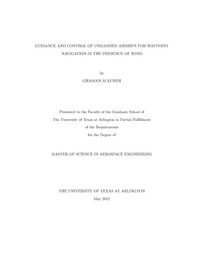
ATTENTION: The works hosted here are being migrated to a new repository that will consolidate resources, improve discoverability, and better show UTA's research impact on the global community. We will update authors as the migration progresses. Please see MavMatrix for more information.
Show simple item record
| dc.contributor.author | Atmeh, Ghassan M. | en_US |
| dc.date.accessioned | 2012-07-25T19:08:46Z | |
| dc.date.available | 2012-07-25T19:08:46Z | |
| dc.date.issued | 2012-07-25 | |
| dc.date.submitted | January 2012 | en_US |
| dc.identifier.other | DISS-11717 | en_US |
| dc.identifier.uri | http://hdl.handle.net/10106/11058 | |
| dc.description.abstract | Airships are a specific class of Lighter-Than-Air (LTA) vehicles. These vehicles achieve lift mainly through buoyancy; the usually ellipsoidal shaped hull contains a lifting gas such as helium, which produces the required lift though air displacement. Due to this method of operation an airship has the ability to conduct low-power hover, which makes it ideal for applications requiring hovering over long periods of time such as surveillance, terrain mapping, meteorology and GPS. In such applications the conventional fixed wing unmanned aircraft is less suitable. The work presented in this thesis deals with designing a controller that is capable of navigating an airship through a series of waypoints. A guidance algorithm provides commands to the controller based on vehicle and waypoint positions (two approaches were considered). A novel implementation of the extended Kalman filter (EKF) provides the required states and wind speed estimates to increase the control systems robustness to wind. Translational and rotational kinematics and dynamics for the AS500 unmanned airship are developed using classical mechanics principles, resulting in a nonlinear model. Airship dynamics differ strongly from conventional aircraft dynamics for they exhibit virtual mass and virtual inertia effects, the aerodynamic model incorporated in this work take into account these effects as the airship moves through air. The developed model is trimmed at two points, one for a straight and level flight the other for a level turn. These trim points are then incorporated in the linearization of the airship model, which results in a twelve-state, linear, state-space model. The linear model acquired is then used to design an Linear Quadratic Regulator (LQR) control law, a Linear Quadratic Integral (LQI) control law, and a gain scheduling law, which allow the airship to navigate through several waypoints. Two waypoint navigation laws are developed to generate command signals to the roposed controllers. The results from both cases are compared under specified wind conditions. A novel implementation of the Extended Kalman filter (EKF) is employed to estimate the airship entire state vector, angular rates measurement bias, and wind speeds with only two sensors available; a global positioning system (GPS) and inertial measurement unit (IMU) sensor. It is shown that the inclusion of the estimated wind speeds enhances the robustness of the track following guidance law to wind. The nonlinear model, proposed LQR and LQI controller, along with the guidance laws, and Extended Kalman filter are implemented to simulate the flight of the unmanned airship through a series of waypoints, in the presence of a wind field generated from an exponentially correlated wind model. | en_US |
| dc.description.sponsorship | Subbarao, Kamesh | en_US |
| dc.language.iso | en | en_US |
| dc.publisher | Aerospace Engineering | en_US |
| dc.title | Guidance And Control Of Unmanned Airships For Waypoint Navigation In The Presence Of Wind | en_US |
| dc.type | M.S. | en_US |
| dc.contributor.committeeChair | Subbarao, Kamesh | en_US |
| dc.degree.department | Aerospace Engineering | en_US |
| dc.degree.discipline | Aerospace Engineering | en_US |
| dc.degree.grantor | University of Texas at Arlington | en_US |
| dc.degree.level | masters | en_US |
| dc.degree.name | M.S. | en_US |
Files in this item
- Name:
- Atmeh_uta_2502M_11717.pdf
- Size:
- 2.737Mb
- Format:
- PDF
This item appears in the following Collection(s)
Show simple item record


